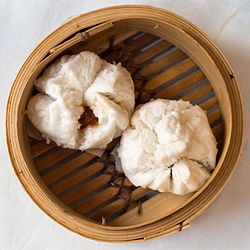General stuffed dishes







- A-gei
- Chả giò
- Chatti pathiri
- Chaudin – a meat dish from southern Louisiana; it is a sausage-like variant made from ingredients such as spices, pork, rice and vegetables that are sewn up in a pig's stomach, which is then cooked. [1] [2] The dish is sometimes smoked.
- Chicken Kiev
- Chiles en nogada
- Cordon bleu
- Deviled egg
- Dolma – a family of stuffed vegetable dishes common in the Middle East and surrounding regions including the Balkans, the Caucasus, Russia and Central Asia. Common vegetables to stuff include tomato, pepper, onion, zucchini, eggplant, and garlic. Dolmas may also be wrapped in e.g. grape or cabbage leaves (and thus not strictly stuffed). The stuffing may or may not include meat.
- Dorma – a variant of dolma popular in West Bengal and Bangladesh, in which potol is stuffed with fish.
- Drob
- Eggah
- Empanada
- Figolla
- Galantine
- Ghapama – a filled pumpkin dish from Armenia made by hollowing out and stuffing a pumpkin with rice, dried fruits, meat, spices and more, there are multiple variations and this dish is often called the national dish of Armenian cuisine.
- Gołąbki
- Gordita
- Guanime
- Gyeran-mari
- Haggis
- Hallaca
- Helzel
- Hotteok
- İmam bayıldı
- Jalangkote
- Jalapeño popper
- Jamaican patty
- Kab yob (Hmong term for the dish known in English as egg roll)
- Kachori
- Kalitsounia
- Karađorđeva šnicla
- Karnıyarık
- Khai yat sai
- Kibbeh
- Kibinai
- Knish
- Kousa mahshi
- Krautshäuptchen
- Ladera – sometimes stuffed
- Lechona
- Lemper
- Llapingacho
- Manok pansoh
- À la Maréchale
- Mirchi bada
- Mücver
- Murtabak
- Nacatamal
- Onigiri
- Papa rellena
- Paste
- Pastel
- Pasteles
- Pasztecik szczeciński
- Pirozhki
- Plátanos rellenos – a typical dish of the Veracruz coast, consisting of plantain stuffed with meat and seasonings and fried. [3]
- Pocket sandwich
- Porchetta
- Pupusa de arroz
- Qistibi
- Quesito
- Rellenong talong
- Rissole
- Rouladen
- Sajji
- Sakhu sai mu
- Samgye-tang
- Stuffed leaves













